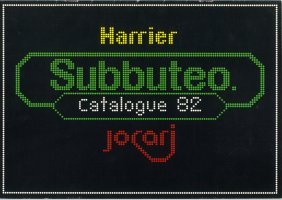
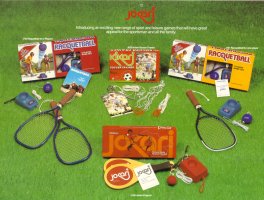
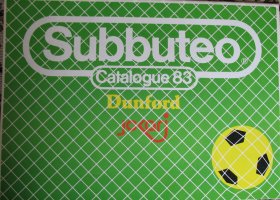
| Peter Upton's |
Subbuteo Tribute Page. |
|
The North American Experience (Part two). |
|
The Jokari Company link-up - 1982-83. |
|
Plus Dunford Kites - 1983-84. |
In 1982 Waddingtons/Subbuteo Sports Games joined with American company Jokari to export Subbuteo to the North American market. This was designed to cash-in on the Soccer boom that had accompanied the North American Soccer League in the 1970s. Sadly, their timing was not so great. By the early 1980s, most of the famous players who had graced the NASL had retired, and the league was limping to bankrupcy. I've been told that although Jokari were still selling Subbuteo in the late 1980s, their customer services had clearly lost interest in it.
My site has full details of Subbuteo's North American Range Just follow the link.



However, there was a second side to this North-Atlantic co-operation. The Subbuteo Sports Games trade catalogue of 1982 featured a Jokari section, with the games from this American company offered to Subbuteo's European retailers. Although I have had scans of the 1982 trade catalogue for years, I assumed this was just a sharing of space, and that the two ranges had no actual physical link. However, Italian collectors who have been picking up Jokari products, have found that the Subbuteo logo was added to both the boxes and instructions. As this site is designed to catalogue all Subbuteo branded releases, it seems appropriate to add a page to cover this quirky and short term venture.
It is also worth noting that the 1982 catalogue has a third section devoted to "Harrier" products. I was so disinterested in this section when I borrowed the catalogue, that I didn't keep any scans or photocopies of it at all. I think they were wooden gliders, but perhaps someone can enlighten me....
It is also worth a quick appreciation of the 1982 catalogue cover, which looks as if it was knocked up on a ZX Spectrum, another important product from 1982. Computers. They are the future you know.
March 2023: Photos of the 1983 trade catalogue reveal that the Jokari range had continued, and indeed grown, into a second year, as Subbuteo production moved to Waddingtons head office in Leeds. I assume they had to leave the ZX Spectrum behind, as the later catalogue is using a better font. What is odd though, is that the Subbuteo logo is (sensibly) printed on top of the goal netting graphic, but the other firms are printed behind it, which makes them look very secondary. Which perhaps they were.
Jokari - The Game.
As Subbuteo is both the company trade mark, and the name of a distinct game, so it is the case with Jokari. Jokari the game is a paddle ball affair, which according to Wikipedia, was invented in France in 1938 by Louis Joseph Miremont. The game consisted of a rubber ball attached to an anchor by means of a long elastic cord. The ball is hit with a paddle, and the string stops it disappearing over the neighbour's fence..... Like the classic Swingball, the game could be played by two people, or solo. The difference being the lack of a pole. More bending is required....
Jokari®: One, Two, or Four Player Game (primghar.com) is a useful little website for Jokari details. (I always love an enthusiastic amateur website). The game was apparently at its height of popularity in the 1950s. Even my mother remembers it.
It seems a strange link-up for Subbuteo, but actually it did make some sense. The company was called Subbuteo Sports Games, and it was at its height in 1982, with table rugby, cricket and hockey still in production. Even in the 1990s Richard Payne mentions that Subbuteo head Trevor Spencer was still open to "the right opportunities" in regard to extra sports. When you look at the simple items that periodically take hold as school playground crazes (yo-yos are a great example from my youth), it was possible that one of the Jokari products would take the UK by storm.....
In the early 1980s, Subbuteo made an attempt to number all their vast collection of sets and equipment into a unified range. This numbering gave the table soccer sets Sxxx numbers, whilst Hockey was H100, and Sport Billy B010. Even the pens and mugs from the UK Subbuteo Assn were given UKxxx numbers. Here then, is Subbuteo's Jxxx range (and K range too).
Jokari Company products.
J100 Jokari Original.
The Jokari game is a worldwide best seller.
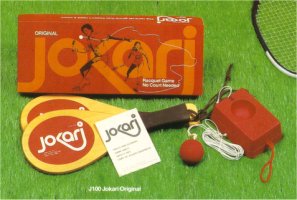

The proper game, with two wooden paddles, the anchor (in red) and attached ball. Subbuteo Sports Games editions have an additional Subbuteo logo sticker on the front of the box.
The catalogue blurb is more exciting than I am going to be, so here we go.
Now we are introducing a superior quality set that will prove its popularity in no time! The set includes two 9-ply varnished wooden bats with rubber gribs; weighted base; rubber ball attached to super-stretch band; and complete instructions. It is a fast moving, hard-hitting game that keeps everyone on their toes - and the great thing about it is, thanks to the super-stretch band, no court is needed. It is a game of great excitement for both older children and sportsmen alike.
Replacement ball and band are available direct from Subbuteo.
J500 Shuttle Volley.


This one didn't feature in the 1982 catalogue, but arrived in 1983. An Italian version exists in the collecting community with Subbuteo branding. The box actually states that the game was made in Taiwan, under licence by Subbuteo Sports Games. The 1981-82 Tyne and Wear address dates the set alongside the others shown here, although the 1983 catalogue gives the Leeds address.
Shuttle Volley is a badminton style of game with wooden paddles, and a low moveable net, designed to be used by two-to-four people, inside or out. The shuttlecocks ("birds") apparently have real feathers and are especially designed for shorter indoor play. Subbuteo explain it thus:-
"This super indoor/outdoor family game for two to four people is suitable for both children and adults and fun for everyone! It is very easy to learn. It comes complete with four special shuttlecocks known as "Hot Birds" which are designed with a parachute action. This means they travel only a short distance no matter how hard they are hit - so it can be played in an area as small as 6' x 10'. The set also includes two plastic bats, a sturdy frame and net, and complete instructions.
Replacement "Hot Birds" are available direct from Subbuteo."
"Hello Subbuteo? Can you send me a couple of hot birds? I'm ready for some exciting indoor action... " Some jokes are just too easy huh?
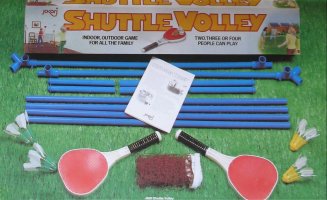
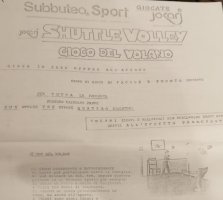
The colour picture above is from the 1983 catalogue. The Italian instructions are a rubbish photocopy, with the all important Subbuteo name on the top. In fact, the game logos look hand-drawn. A labour of love, or just a lack of expense!
J620 Kikari Soccer Trainer.
"Now there's a new exciting way to improve your soccer skills. It's called Kikari. And it's from Subbuteo, makers of the worlds famous table-top game. Kikari* can be played alone for training, or by two players. And because the ball is secured to the ground by a stretch cord, you won't spend half your time running after it! Which means more intensive training and a faster game. The two nets included in the set will fit both a size 4 and 5 soccer ball."
*Please note ball not included.
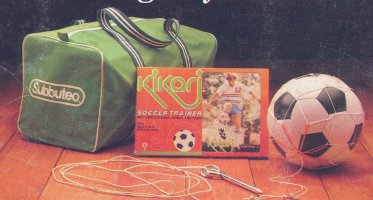
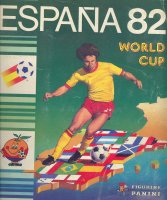
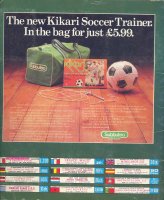
An amusing pun on Jokari. This item used the same general principle as their more famous product. So this is a football that you can't (hopefully) kick through the neighbour's greenhouse. The product is strange, because it doesn't actually include the football. All you get is a metal prong to stick in your lawn, the elastic cord, and a pair of nets, into which you place your football of choice. That sounds a bit lame frankly.
However, Subbuteo clearly had some faith in it, as this product was picked for an advertisement on the reverse of the Panini Espana 82 World Cup sticker book. In theory this would be a huge cross-over market. Here, the Kikari was offered with the classic green Subbuteo sports bag (C200) for only £5.99 (plus £1 postage, and 30 empty sticker packets). I'm guessing that Subbuteo had over produced this bag. It turns up everywhere...... The blurb at the top of the section came from this advert. Did they make it seem more exciting than I did?
If you are wondering, the box has a picture of NASL local hero Kyle Rote (in a classic mid 1970s Dallas Tornado kit), and he also features on the instruction booklet. I imagine this was met with some confusion in the UK market. Kyle who? How much would it have cost to get Glen Hoddle to repeat the picture for the UK market?
Here is the Kikari blurb from the 1983 trade catalogue -
"It is not so easy to practise soccer on your own - unless you have one of these (or a wall, frankly). The Kikari soccer trainer is a great idea for keeping players practising on their own or with others - the ball simply cannot get away! The set is specially for the player who prefers to use his own ball and consists of two nylon ball nets which fit a size 4 or 5 soccer ball, an extremely durable 10 foot stretch band with swivel action ring connecting it to a 7-inch metal stake, and a 40-page illustrated training book."
J701 Racquetball for one player.
This set is made specially to provide practice and exercise for one
person.
Replacement ball and band are available direct from Subbuteo.
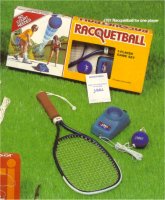
This appears to be an upgraded version of Jokari, with a nice looking metal framed racquet instead of a wooden paddle. The anchor/ball combo turned blue, but I don't know if they is any other difference to the weight of the ball or anything.
J702 Racquetball for 2 players.
The 2-player Racquetball game set includes two superior quality rackets
with rubber gribs, patented J-ball, stretch band, anchor block, and fully
illustrated 34 page guide to playing the game. Quick-off-the-mark game that
keeps players on the move yet does not need a court or a wall - so you can play
anywhere! The patented J-ball and stretch band give the same rebounding action
as court walls would do.
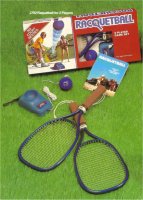
How many different games can you produce from one basic product anyway? This is essentially the same set as J701, but with two racquets in a different colour box. There isn't much more to add really. It's a ball on a long elastic string. Annoy the hell out of your dog.....
As I've mentioned, the Jokari company lost interest in Subbuteo in the late 1980s as the original US soccer boom waned. I don't know how long Subbuteo Sports Games persevered with a Jokari range, but suggest that it was an even shorter affair! The craze clearly never happened.
The Jokari company in the USA still exists, but apparently no longer produce any game products. So the game is fairing even worse that table soccer. Is it time for a revival? No? Okay, suit yourself..... Let's finish this page by looking at the other companies that snuck into the Subbuteo Trade catalogues in the early 1980s.
Harrier (1982).

Subbuteo also share their 1982 Waddingtons Trade Catalogue with products from a company named Harrier. Assuming these were in no way Subbuteo related, I didn't bother to scan the catalogue page when I had the opportunity. This means that I've currently lost the information. If you know who they were, then let me know. I think it was some kind of Balsa wood plane/glider.
Dunford Kites (1983-84).

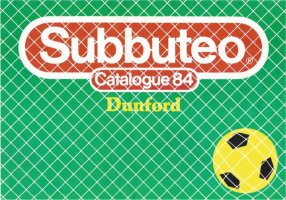
The following year, Harrier had gone, and were replaced by Dunford Kites. Here I have the details, and Subbuteo Sports Games were certainly involved in distribution, as well as offering spares. Jumping the gun this time, I haven't waited for an Italian collector to find one of these kites with Subbuteo branding before adding them! Dunford survived in the trade catalogue until 1984, although Jokari did not.
High Flying Dunford.
A range of aerodynamically designed, high quality exciting kites
which give hours of pleasure to both children and adults.
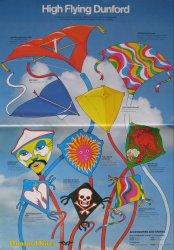
As you can probably make out, the picture in the catalogue is only an illustration, not the actual product. So you'll have to decide whether the kites were high quality, or indeed, exciting.
The kites and their accessories were given K reference numbers. It is worth noting that the kite numbers were designated to the kite designs, and not the illustrations on them. So for the two basic kites at the bottom of the page (designed for youngsters), you have three different colour designs for each reference number.
The details were as follows:-
K050 Flying Machine 1250 (the big red kite in the top left). "Top of the range for the kite expert. Precision flying".
K051 Delta (the blue kite). "Easy to fly single line kite".
K052 Stingray Stunter (the multi coloured kite top right). "Acrobatic stunt kite and winner of 1980 National Acrobatic Kite Championship. Dual string and controllable in gale force winds."
K053 Herald Stunter (the yellow kite). "Dual control stunt kite with fibreglass spars."
K054 Flying Falcon (Dove, Skull and Crossbones, and Flying Falcon shown along the bottom of the page). A lightweight kite for the first time buyer - exceptional value for money."
K055 Line and handle.
K056 Three tail set in three colours.
K059 Shuttle.
K060 Bombs.
K061 Glider.
K062 Parachutes.
K063 Shield (Chinaman, Sunflower and Red Dragon shown). "The single line version of the Herald for the young beginner".
K059-062 were described as accessories, and K055 and K056 were described as spares. I've never flown a kite, so your guess is as good as mine as to what the bombs are, or why you might need a parachute. (It did say you could fly the thing in gale force winds, so perhaps it was better to be safe huh?)
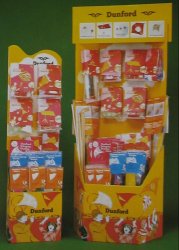
The kite range was also blessed with "free of charge display centre", which was a typical cardboard construction. This promotional display is all Dunford, and Subbuteo is not mentioned. So the link with our hobby is a bit tenuous. However, I thought that about Jokari products too until the logos started appearing, so you never know.
[ Main Page ]